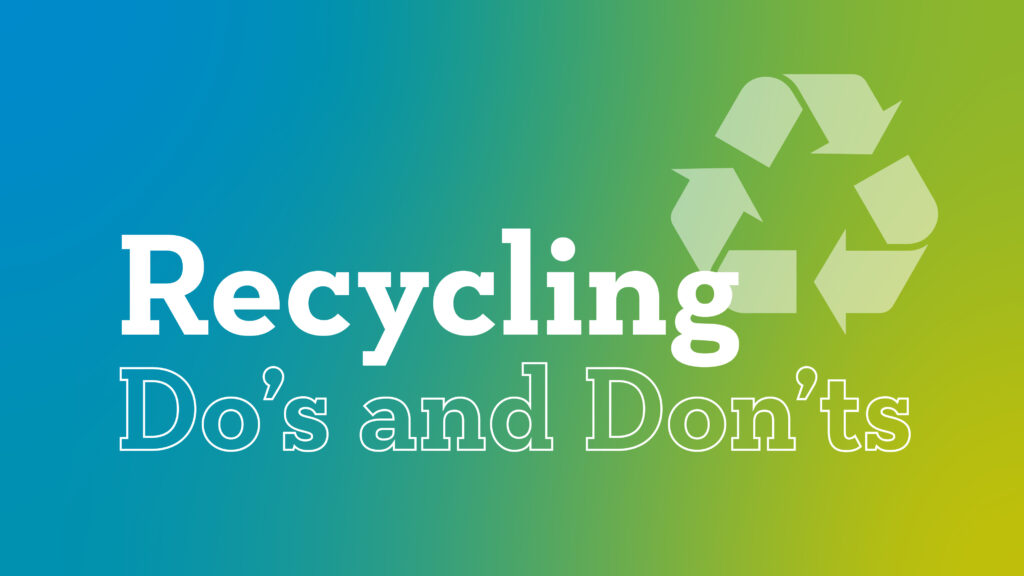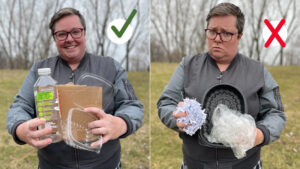How to Recycle for Sustainable Success

Recycling is an easy and convenient way to reduce your trash and protect the environment, but it’s only effective when we follow guidelines for how to recycle in the areas we call home.
Recycling doesn’t just divert waste from landfills, it also provides jobs and supports regional manufacturing. Most of the materials that go into your recycling bin will be utilized locally to create new products and generate revenue. “For example, clear glass is made into bottles for drinks, pickles, salad dressing, and more in Shakopee; plastic milk and laundry detergent jugs are made into durable decking, fencing, and landscaping products in Paynesville; and paper and cardboard are made into cereal and cracker boxes in Saint Paul,” according to the Hennepin County Environmental Services Department. But recycling only works when done correctly.
Hennepin and Carver counties have mixed (or single-sort) recycling for many household waste products such as paper, plastic, glass, and metal cans. That means residents can mix their recyclables together in the same cart or bin. It’s a convenient system for residents, but there are a few guidelines to be aware of so your waste gets where it needs to go in order to be remade into new products.
Recycling do’s and don’ts to keep in mind.

“Wish-cycling,” or throwing things into the recycling bin because you hope they’re recyclable, but you’re not sure, results in contamination of loads of recyclable items. Things that aren’t recyclable such as shredded paper, loose bottle tops, and small scraps of metal or plastic can end up contaminating the glass load, making it harder or impossible to recycle the entire load. When in doubt, throw it out!
DO Recycle:
- Paper such as magazines, junk mail, newspapers, and phone books, as well as cardboard boxes and cartons such as juice boxes, milk cartons, aseptic shelf-stable containers (a.k.a Tetra Paks), and gift boxes. Cartons and boxes for things stored in the cupboard or fridge are recyclable, but freezer boxes generally are not recyclable. Note: Break down or flatten all boxes. Hennepin County only accepts cardboard that is 3 x 3 feet or smaller, so you may need to cut down larger boxes. Take shredded paper to special facilities or recycling events.
- Plastic bottles, jugs, cups, and containers that are labeled #1, 2, and 5 that are not black and have not held hazardous chemicals. There are strong markets to recycle these plastics into new products! Give a rinse or scrape out food residue before recycling. Pumps from spray bottles or cosmetics are not recyclable, so toss those in the garbage before recycling the bottle.
- Metal food and beverage cans, as well as clean, dry aluminum foil and pans. Note: Collect your clean, dry sheets of aluminum foil into a ball until it’s about the size of a baseball before tossing it into your curbside recycling (no food residue or moisture).
- Glass food and beverage bottles and jars, just rinse or scrape out food residue before tossing it in the recycling bin.
DON’T put these items in your curbside recycling:
- Plastic bags, cling wrap, or plastic film. These items damage equipment and require workers to physically cut them out of sorting machines.
- Black plastic, plastic foam (Styrofoam), bulky plastic items such as laundry baskets or storage tubs. Avoid throwing #3, #4 or #7 plastic items in your curbside recycling bin. These types of plastics aren’t recyclable in our region, so avoid purchasing them when you can.
- Shredded paper. Cardboard or paper products need to be about the size of your palm or bigger to be recycled. Bring shredded paper to shredding events for recycling.
- Paper plates, plastic utensils, napkins, paper towels, or paper products soiled with food or grease.
- Random metal items such as pots and pans, pipes, hangers, and tools. These can damage equipment and harm workers at recycling facilities. All metal can be recycled, just not in your recycling cart at home. Take random metal items to a scrap metal recycler.
Brush up on what is and isn’t recyclable with this useful guide from Hennepin County.
Feeling overwhelmed? Start with the 3 R’s.
The 3 R’s of recycling are a great way to remember and practice green living day to day. Keep the phrase “reduce, reuse, recycle” in mind when considering how to dispose of something and whether it’s time to get something new.
Reduce
Start with “reduce,” and think about your purchases with these questions in mind:
- Do I actually need this and will I use it up in time or regularly?
- Is there an option with less packaging?
- Do I have something similar that would work just as well?
Need some inspiration to help you succeed in your efforts to reduce? Check out these simple actions you can take at home, when shopping, and at work to help build habits that help you reduce waste.
Reuse
Once you’ve purchased an item and it’s been used up or you no longer need it, think next about the “reuse” phase, and use the questions below to help you decide what to do with it, or with its packaging:
- Can I reuse it a few more times before I throw it away or recycle it?
- Could this item have another use beyond its original purpose (think storage, cleaning rags, packing material, arts and crafts, etc.)?
- If it’s still in good shape, might others have a use for it?
Not sure how something might be used again, or whether it can be repaired? Head to the Reuse Minnesota website for resources, swap events, fix-it clinics, donation suggestions, and more!
Recycle
Everything wears out eventually. When that time comes, it’s important to know how to dispose of things responsibly. Can you recycle it, or does it need to be handled in a certain way? Curbside recycling can take care of most of our paper, cartons, glass, metal cans, and certain plastics, but what can we do with the rest of our waste that could end up in the landfill? Here are some resources that explain how to divert the items you can’t easily recycle or compost at home.
- Residents of Carver County can select from the interactive list in the A-Z Residential Disposal Guide to see where and how to dispose of things like motor oil, medicines and sharps, fixtures and building materials, shredded paper, and more.
- Need to drop off items at the Carver County Environmental Center? Plan ahead and find out what’s accepted free of charge and what items cost a small fee to recycle with their handy brochure.
- Residents of Hennepin County can find out where and how to dispose of common items such as scrap metal, paint, light bulbs, mattresses, appliances, electronics, and more at Hennepin County’s Green Disposal Guide. Or search for the specific items you’re trying to dispose of in their extensive list — from adhesives to yard waste and just about everything in between!
- Remodeling or making upgrades around the house? Better Futures MN helps keep millions of tons of building materials out of Minnesota landfills through their deconstruction service and ReUse Warehouse. Find out what’s accepted.
Building better recycling habits at home ensures more recyclable materials make it to the local manufacturers who will remake them into new products. Discover more ways to build eco-friendly habits at home with our green living action resources.
